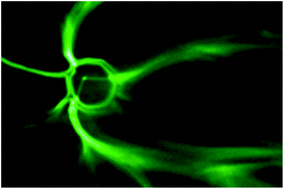Most biological organisms depend on electrical signals to function properly. For instance, neurons are electrically active cells that transmit signals to other neurons using electrical signals known as action potentials. Other electrically active cells such as cardiomyocytes in the heart spontaneously generate electrical signals that regulate normal heart rhythm. Additionally, electrical signals are also known to mediate certain processes such as cell migration and cell division. Knowing that biological organisms rely on electrical signals to function, biomaterials scientists are searching for opportunities on how to use innovative electrically conductive materials to deepen our understanding of fundamental biological processes.
Professor Bozhi Tian and his team at the University of Chicago have recently written a mini-review discussing nanoscale semiconductor devices and how they can revolutionize our understanding of cellular electrophysiology. Semiconductor devices such as silicon nanowire field effect transistors (NWFETs) operate at a sufficient resolution to detect the slightest changes in chemical and electrical signals (down to the pico- and femto- unit scales). These devices could theoretically be used as a low-cost strategy for disease marker detection in the clinic.
Ramya Parameswaran, an MD/PhD student at the University of Chicago and second author on the mini-review, explains that the use of nanoscale semiconductor devices in the clinic is not far away. The authors discuss the development of “multiplex sensing” semiconductor devices seek to replace enzyme-linked immunosorbent assays (ELISA) in the future, with the ability to detect concentrations of proteins, nucleic acids, and other ions within cells simultaneously with one device. “Multiplexing nanomaterials can hopefully soon be used to detect biomarkers such as cancer antigens or other important players involved in disease processes in a rapid fashion,” says Parameswaran. “While clinical trials for devices such as these have not been performed as of yet, the proof of concept exists.” These devices would ultimately accelerate patient diagnosis, and would ideally improve patient treatments for a variety of diseases.
The application of nanoscale semiconductor devices in the tissue-engineering field is also emerging. Nanoscale semiconductors embedded in tissue-engineered implants could be used to record electrical information for monitoring and ensuring proper functionality of the implant. Interestingly, nanoelectronic scaffolds can be used for a variety of tissue targets. “Free-standing nanowire nanoelectronic scaffolds can be interfaced with neurons, smooth muscle cells, and cardiomyocytes to monitor local electrical activity within the hybrid scaffolds,” says Parameswaran. Using these nanoelectronic scaffolds, tissue responses to drug treatments could also be “monitored meticulously,” which is another advantage for accelerating the translation of these devices to the clinic.
This mini-review describes the current status of nanoscale semiconductor devices and how they can advance our understanding of cell electrophysiology. Additionally, these devices could have a transformative role in the design of medical devices and tissue engineering scaffolds for clinical applications.
Nanoscale semiconductor devices as new biomaterials
John Zimmerman, Ramya Parmeswaran, and Bozhi Tian
Biomaterial Sci., Advance Article, DOI: 10.1039/C3BM60280J
Brian Aguado is currently a Ph.D. Candidate and NSF Fellow in the Biomedical Engineering department at Northwestern University. He holds a B.S. degree in Biomechanical Engineering from Stanford University and a M.S. degree in Biomedical Engineering from Northwestern University. Read more about Brian’s research publications here.
To keep up-to-date with all the latest research, sign-up to our RSS feed or Table of contents











